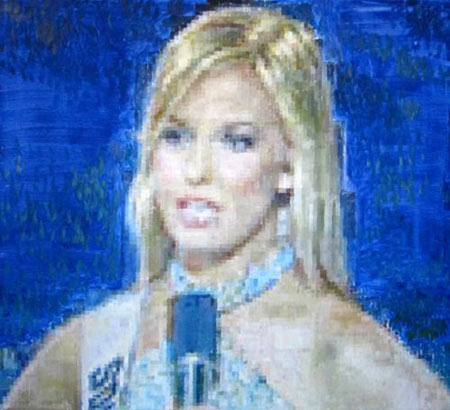Where does ‘fair use’ begin (or end)?

Art critic Regina Hackett just blogged about this portrait painted by Jesse Edwards (see the artist’s website here). I couldn’t help but think about Rob’s post about ‘fair use’ from the other day again: When or where does ‘fair use’ begin (or end)? When is a use not fair?
(updated below - twice)
In the case Rob mentioned, a sculptor whose work was in someone else’s photo claimed it was not fair use. How about doing it the other way around - what if someone took a photo and produced a sculpture that shows the scene of the photo? Is the creation of a sculpture from a photo ‘fair use’? Does the sculptor have to ask the photographer for permission - given that Rob’s sculptor thinks you can’t take a photo that includes his sculpture?
Likewise, can you just paint a pixelated photograph? Is that fair use? (note, we’re in Shepard Fairey territory here)
This is what the law actually says:
“One of the more important limitations is the doctrine of “fair use.” The doctrine of fair use has developed through a substantial number of court decisions over the years and has been codified in section 107 of the copyright law.
“Section 107 contains a list of the various purposes for which the reproduction of a particular work may be considered fair, such as criticism, comment, news reporting, teaching, scholarship, and research. Section 107 also sets out four factors to be considered in determining whether or not a particular use is fair:
” 1. The purpose and character of the use, including whether such use is of commercial nature or is for nonprofit educational purposes
2. The nature of the copyrighted work
3. The amount and substantiality of the portion used in relation to the copyrighted work as a whole
4. The effect of the use upon the potential market for, or value of, the copyrighted work
“The distinction between fair use and infringement may be unclear and not easily defined. There is no specific number of words, lines, or notes that may safely be taken without permission.
“Acknowledging the source of the copyrighted material does not substitute for obtaining permission.”
Needless to say, copyright law in other countries can differ quite a bit from this.
From these lines it’s pretty obvious why Rob writes that “fair use needs a stronger definition.” The big question is now how to produce such a stronger definition, which manages to protect artists from their art being “stolen” (or “misused” or whatever other word you want to use), and which allows artists to produce art that incorporates other people’s art in whatever way.
I’ve thought about this whole complex for a while now, and I’m afraid I don’t have a good answer that will satisfy each and every case mentioned in this post at the same time.
For a while, I toyed with what you might call the “inversion principle”: If you transform a piece of art done in some medium a into something done in a different medium b, then it can only be called fair use, if you would call it fair use if it went the other way around. For example, if you want to make a sculpture out of a painting, then you’d have to be equally happy with someone making a painting out of the sculpture. Unfortunately, once you insert “photo” in there (instead of “painting”) trouble ensues.
In the end, it really comes down to what the current law calls “the amount and substantiality of the portion used in relation to the copyrighted work as a whole” - how does one define this more strongly?
Ideas anyone?
Update (4 February 2010): David Friedman emailed me (thank you!) with an actual fair-use case involving sculpture and photography that had made it to the courts: “A photographer named Art Rogers took a black and white photo of two people with a bunch of puppies. Jeff Koons saw the photo on a postcard and made a sculpture from it. Rogers sued Koons and won. This website highlights the issues considered by the court, and why they ruled in the photographer’s favor despite Koons’ claim of fair use”.
To quote from the article: “The court found Koons infringed Rogers’ copyright, concluding that:
* Rogers’ photo did indeed have sufficient originality (in the lighting, composition, angle etc.) to merit its own copyright;
* Koons had copied the photograph, as he admitted having access to the image and his instructions to his artisans commanded them to copy it closely;
* This direct evidence of copying and the substantial similarity between the two works was enough to infer copying; and,
* Koons had not just taken Rogers’ idea, but also the expression of it, rendering the copying illegal.”
Note the “substantial similarity between the two works” here (see “the amount and substantiality of the portion used in relation to the copyrighted work as a whole” from copyright law cited above).
Oh, and David also sent me another article, also about Koons and (un)fair use.
Update (5 February 2010): And more.